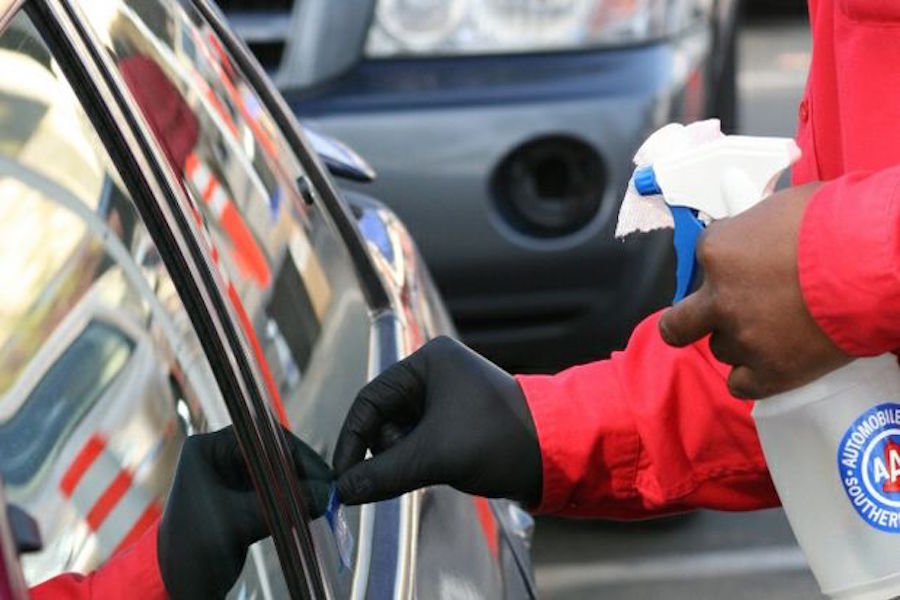
An Automobile Club of Southern California employee etches a vehicle identification number onto a motorist’s window. Photo courtesy of AAA.
California leads the nation in a lot of categories: environmental legislation, almond production and the number of National Football League teams to leave a city before eventually coming back (welcome home Rams). It also leads the country in car theft rates, and, in an effort to help curb that trend, the Automobile Club of Southern California (AAA) is hosting a free event next Thursday that’s open to the public to make vehicles less desirable targets.
During a five hour window on August 18, AAA will host a window-etching event at its Long Beach branch, where owners can bring their vehicles in to quickly add their vehicle’s identification number (VIN) to their car’s windows. The event will be co-hosted by the Long Beach Police Department (LBPD) and the National Insurance Crime Bureau (NICB) and will be the last of the quarterly events held by AAA this year.
Elaine Beno, spokesperson for AAA, said that the acid application of the VIN to the window surfaces results in a light white marker that makes vehicles less attractive to car thieves while adding another layer of protection to your vehicle. The VIN measures about two inches long and is about a quarter inch tall and takes approximately six minutes to apply, Beno said. She said the process is not the cure, but makes things significantly more expensive for thieves to try and change VIN numbers on stolen cars.
“If they wanted to change the identification number on the front dash plate, they’re going to have to change out the windows, too,” Beno said. “And they don’t want to do that; it costs them money to do that.”
VIN number applications on other car parts like catalytic converters and others commonly stolen for their resale value became law in 1984, when the Motor Vehicle Theft Law Enforcement Act was created to try and stunt the theft of cars for their parts. While the original legislation has undergone a fair share of amendments, those changes haven’t extended to marking a vehicle’s windows with VIN numbers.
LBPD Lieutenant Joe Gaynor said these additional markings can also lead to trouble for thieves hoping to sell the parts or cars they’ve stolen. Stiff federal penalties can also be levied against those running “chop shops” under the expansion of the 1984 law.
“If they do steal a car, they’re looking to scrap it and sell the parts,” Gaynor said. “A lot of the places will not buy equipment or parts from cars that have the VIN numbers on them if they don’t match up to the car. If they’re trying to sell a window that has an etching, the buyer, if reputable, will look at it and say ‘that’s from a window that might be stolen and we don’t want any part of it.’”
Etching windows is a fairly new practice for the Southern California AAA—it started the practice in 2010—but had been common in other parts of the country prior to its adoption in California. The club has hosted 32 such events since then, marking over 3,000 vehicles with window VINs and “slowly but surely” raising awareness about auto thefts for Southern Californian motorists.
Long Beach has experienced a spike in car thefts this year, with 1,352 grand theft auto crimes logged by the LBPD as of June. A majority of these crimes—594 total—occurred in the department’s West Division. That sum represents an increase of about 15 percent over the previous five years. Auto burglaries, while down over 11 percent during the same period of time, are nearing 1,000 total reports this year.
Gaynor said even if the figures were lower he would still be on board with partnering with the program to further drive the figures down. He said the etching will be AAA’s part of the event, but LBPD officers in attendance will be trying to educate residents on how to minimize the chances of becoming a part of car theft statistics.
“We’re going to be out there trying to provide information and tips on how to not get your car victimized and prevent your car from being stolen or burglarized,” Gaynor said. “Any time we have an opportunity to partner with someone that’s looking to prevent thefts that’s where we take the opportunity to jump on board with it.”
The most stolen car in the nation, according to the NCIB 2015 “Hot Wheels” report issued earlier this month, is the 1996 Honda Accord, with 52,244 stolen last year. Rounding out the top five are the 1998 Honda Civic, 2006 Ford Pickup, 2004 Chevrolet Pickup and the 2014 Toyota Camry.
“While older vehicles still dominate our Hot Wheels most stolen list, the number of late model vehicles with anti-theft protection on the list goes to show that technology isn’t foolproof,” NICB President and CEO Joe Wehrle said the release last week. “Criminals are doing their best to defeat anti-theft technology through hacking and other means while, at the same time, manufacturers and others are working to improve security.”
Like Wehrle, Beno said common sense tactics also help prevent theft. She said simple measures like not leaving spare keys in your vehicle, parking it in a safe place or in a garage and using low-tech anti-theft devices can create a cumulative effect of theft prevention.
The club will be offering a limited amount of The Club steering wheel locking devices made popular during the 1990s to motorists with high-risk, older model cars who attend the event.
The event will be held Thursday August 18 at the Auto Club’s Long Beach branch located at 4800 Airport Plaza Drive from 10:00AM-3:00PM. It’s open to both AAA members and non-members who provide current vehicle registrations and driver licenses.

